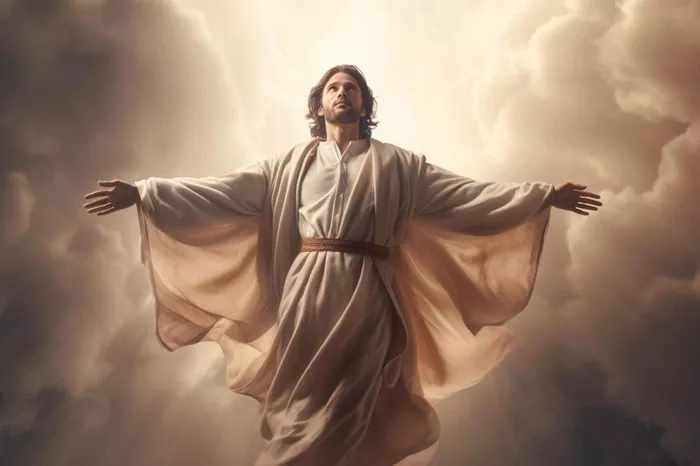Easter is the cornerstone of the Christian faith, celebrating the resurrection of Jesus Christ. Central to this celebration is the imagery of the lamb, symbolizing Jesus as the ultimate sacrifice for humanity’s sins. This article explores 18 significant Bible verses that highlight the profound symbolism of the lamb in relation to Easter, providing context and reflection for each.
18 Easter Lamb Bible Verses
1. John 1:29
“The next day John saw Jesus coming toward him and said, ‘Look, the Lamb of God, who takes away the sin of the world!'”
John the Baptist’s declaration introduces Jesus as the “Lamb of God,” directly linking Him to the sacrificial lambs of the Old Testament. This identification sets the stage for understanding Jesus’ role in God’s redemptive plan.
2. Isaiah 53:7
“He was oppressed and afflicted, yet he did not open his mouth; he was led like a lamb to the slaughter…”
This prophetic verse from Isaiah portrays the suffering servant, a foreshadowing of Jesus’ silent endurance during His trial and crucifixion. The lamb imagery emphasizes innocence and submission.
3. Exodus 12:5
“Your lamb shall be without blemish, a male a year old…”
In the original Passover, the Israelites were instructed to sacrifice a spotless lamb. This requirement prefigures Jesus, the sinless Lamb, whose sacrifice delivers believers from spiritual death.
4. 1 Corinthians 5:7
“For Christ, our Passover lamb, has been sacrificed.”
Paul explicitly connects Jesus to the Passover lamb, highlighting the fulfillment of the Old Testament ritual in Christ’s death, which brings liberation from sin.
5. 1 Peter 1:19
“But with the precious blood of Christ, a lamb without blemish or defect.”
Peter emphasizes the purity of Jesus, aligning with the Passover lamb’s requirements, and underscores the value of His sacrificial blood in redeeming believers.
6. Revelation 5:6
“Then I saw a Lamb, looking as if it had been slain, standing at the center of the throne…”
In John’s vision, the slain yet standing Lamb symbolizes Jesus’ death and resurrection. His position at the throne’s center signifies His authority and central role in salvation.
7. Genesis 22:7-8
“Isaac spoke up and said to his father Abraham, ‘…Where is the lamb for the burnt offering?’ Abraham answered, ‘God himself will provide the lamb…'”
This exchange between Abraham and Isaac foreshadows God’s provision of Jesus as the ultimate sacrifice, emphasizing divine provision and faith.
8. Revelation 7:17
“For the Lamb at the center of the throne will be their shepherd; he will lead them to springs of living water…”
Here, the Lamb is also the Shepherd, illustrating Jesus’ dual role as sacrifice and guide, leading believers to eternal life and comfort.
9. Revelation 13:8
“…the Lamb who was slain from the creation of the world.”
This verse reveals the eternal nature of Jesus’ sacrificial role, indicating that God’s plan for redemption through the Lamb was established from the beginning.
10. Acts 8:32
“He was led like a sheep to the slaughter, and as a lamb before its shearer is silent…”
This passage, quoted by the Ethiopian eunuch, reflects on Isaiah’s prophecy and its fulfillment in Jesus, highlighting His willing submission to suffering.
11. Revelation 5:12
“Worthy is the Lamb, who was slain, to receive power and wealth and wisdom and strength…”
A heavenly chorus praises the Lamb, acknowledging His worthiness due to His sacrificial death, which brings redemption and warrants honor and glory.
12. Revelation 21:23
“The city does not need the sun or the moon…for the glory of God gives it light, and the Lamb is its lamp.”
In the New Jerusalem, the Lamb is the source of light, symbolizing purity, guidance, and the eternal presence of Christ with His people.
13. Exodus 12:3
“Tell the whole community of Israel that on the tenth day of this month each man is to take a lamb…”
This instruction initiates the first Passover, setting a precedent for the sacrificial system that points to Jesus’ ultimate sacrifice.
14. Revelation 7:10
“Salvation belongs to our God…and to the Lamb.”
The multitude’s proclamation attributes salvation to both God and the Lamb, emphasizing Jesus’ integral role in the divine plan of redemption.
15. Revelation 19:7
“Let us rejoice and be glad and give him glory! For the wedding of the Lamb has come…”
The marriage of the Lamb represents the union between Christ and the Church, celebrating the culmination of God’s redemptive work.
16. 1 Peter 1:18-19
“For you know that it was not with perishable things…but with the precious blood of Christ, a lamb without blemish or defect.”
Peter reiterates the theme of redemption through Christ’s pure and invaluable sacrifice, contrasting it with earthly wealth.
17. Revelation 21:22
“I did not see a temple in the city, because the Lord God Almighty and the Lamb are its temple.”
In the eternal city, God’s presence with the Lamb eliminates the need for a physical temple, signifying direct communion with the divine.
18. Revelation 22:3
“The throne of God and of the Lamb will be in the city, and his servants will serve him.”
This verse concludes the biblical narrative, depicting the Lamb’s eternal reign and the fulfillment of God’s promise of restoration.
Conclusion
The imagery of the lamb permeates Scripture, culminating in the person and work of Jesus Christ. From the Passover in Exodus to the visions in Revelation, the lamb symbolizes sacrifice, purity, and redemption. As we reflect on these verses during Easter, we are reminded of the profound love and grace demonstrated through the Lamb of God, who takes away the sin of the world
You Might Be Interested In:


